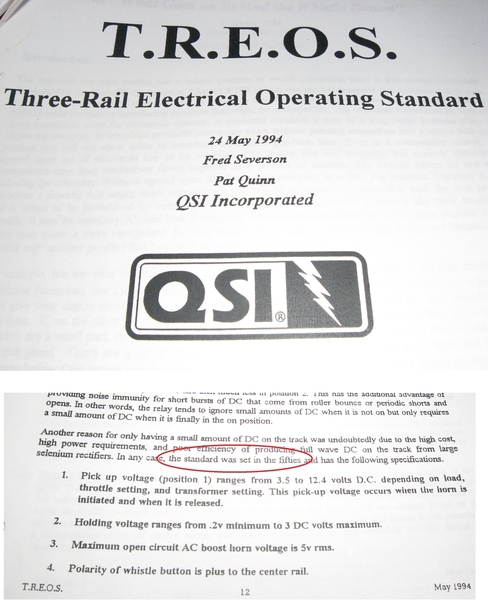In the Lionel Test Station instructions, don't have one, just the instructions, there is a test done with the whistle where you dial in 0.8VDC. In transformers with a whistle control, the compensating winding is 6VAC with a copper oxide rectifier that should give about 3 volts DC. But, it is shunted with a resistor that is nothing more than about 8 inches of insulated wire when the whistle is pushed, basically, shorting out the diode with a very low ohm resistance At the diode, I see abut 3VDC when no whistle, push the whistle and it goes to only a few tenths, about 0.5VDC. Is that all it takes to pull in the relay in the tender and hold it? I have a silicon diode in the circuit now, the copper oxide seemed to be bad, as it had no 3VDC unloaded, was zero, but when the whistle was pushed, I did see the same 0.5VDC I now get with a top hat rectifier installed.
Replies sorted oldest to newest
The shunt resistor was there to reduce the current through the copper oxide rectifier. There is an intermediate position on the whistle control that puts DC on the track without the shunt resistor in the circuit. This is the position where the relay should lift. The shunted position is only a relay holding position. The shunt resistor is in the 1.8 to 2 ohm range. The inserting of the transformer boost coil is to compensate for the current draw of the whistle motor and should not result in much voltage difference at the loco. All this theory falls apart when a horn is being blown.
I did not read the value of the shunt, but unless it is nicrhome wire, no way 8 inches of #22 solid is 2 ohms. You have piqued my interest, will have to take the cover off and check it. What is interesting about the RW transformer, is that if you push the whistle button part way, it actually shorts the compensating winding out through the diode and shunt. The 'H' shaped contacts are broad enough that it bridges all the connections half way pushed.
The whistle switches in Lionel transformers are designed to make before breaking the circuit. This is done to prevent the e unit from cycling during whistle operation.
Thanks for the input, but nobody really said what the DC track voltage is when the whistle is pushed on their layout. The DC meter may indicate a low level with AC track power up, but it will go up higher when when the whistle is pushed, and wondered what the difference you see is.
@CALNNC posted:nobody really said what the DC track voltage is when the whistle is pushed on their layout.
Z4000 - 1 VDC
Z Controller - 1.5 VDC
ZW - 1 VDC
6-5906 Sound Activator - 1.5 VDC
CW80 - 1 VDC
DC values may change depending up AC level and transformer load.
@CALNNC posted:Thanks for the input, but nobody really said what the DC track voltage is when the whistle is pushed on their layout.
OK - Using an LW, powering a 2037 and a 6046W, pulling a half dozen PW cars. Measurements taken with a Fluke 87 true-RMS multimeter.
Track AC volts - about 14 - not flying of the track, but close
Track AC amps - about 3
Track DC volts with whistle blowing - 1.4
This is about the "sweet spot" for the PW whistle system, at 3 amps the 2 ohm resistor drops about 6 volts, which is corrected by the 6 volts from the compensating winding. Train speed does not vary noticeably when the whistle is sounding.
FWIW, Lionel did make a whistle controller that was nothing more than a "D" cell and a fast-acting switch. That put 1.5 vdc on the track with no regard for load or ac voltage, providing the battery was fresh..
I realize you're looking for practical "as-built" measurements, but if you're trying to peel the layers of the onion refer to the TREOS or T.R.E.O.S. Three-Rail-Electrical-Operating-Standard which goes into exhausting detail on these matters. Apparently there is even some standard from the 50's which begat TREOS. There have been discussions on OGR and elsewhere on TREOS and the what, how, why, etc. of 3-rail DC-offset.
Attachments
Thanks, Stan, prof and Bruce, the question has been answered and then some.
@PLCProf posted:FWIW, Lionel did make a whistle controller that was nothing more than a "D" cell and a fast-acting switch. That put 1.5 vdc on the track with no regard for load or ac voltage, providing the battery was fresh..
No. 147. One 'D' Cell under the cover. I bought one when I was 12 because I couldn't afford a new transformer with a built-in whistle button when I found my first whistling tender at a yard sale. Worked like a charm, as long as you could tolerate the slowdown as the whistle motor spooled up to speed.

Mike








